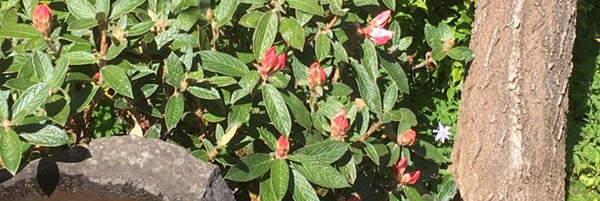Rhododendron edgeworthii is a showstopper year round. The blooms are borne on trusses of three to four flowers. The flowers are large, funnel shaped, and delightfully fragrant. Flowers range from white to white tinged red to white tinged pink. The mature bark is smooth, glossy, and peeling. The underside of the leaves and young stems have a tawny colored woolly indumentum making them feel very soft. For UW Botanic Gardens Horticulturist Annie Bilotta, the indumentum and dark green puckered leaves are what set this species apart from many rhododendrons.
This species was discovered by J.D. Hooker in the Himalayas in 1849. It was named for M.P. Edgeworth who was a commissioner with the Bengal Civil Service. It is native to NE India, Tibet, Bhutan, Myanmar, and SW China. It grows in a wide range of habitats including cliffs, rocky fields, deciduous and mixed forests and is typically found at elevations of 6000 to 13,000 feet.
Rhododendron edgeworthii is also an epiphyte, which means that it is a plant that grows on another plant without taking any nutrients from that plant. The thing that blows my mind is that these rhodies are often found growing at the tops of tall trees or in snags! I have personally never seen anything like that.
R. edgeworthii is a good candidate for the Pacific Northwest garden. It prefers a partially shaded site as it can get leggy in full shade and burn in full sun. In its native habitat it can grow to 12 feet but in cultivation it is typically three to four feet tall. It also works well as a container plant. Come by in the early weeks of May to see this lovely gem in bloom! Three plants are located at the Center for Urban Horticulture in the Fragrance Garden, next to the little stone fountain.
Family: Ericaceae
Genus:
Rhododendron
Species:
edgeworthii
Origin: Himalayas, NE India, Bhutan, Myanmar, SW China
Height and spread: 3-4 feet
Bloom time: Mid spring
Location: Seattle Garden Club Fragrance Garden at the Center for Urban Horticulture



No comments:
Post a Comment